Understanding Mattress Sizes: From Twin To King, We Explain It
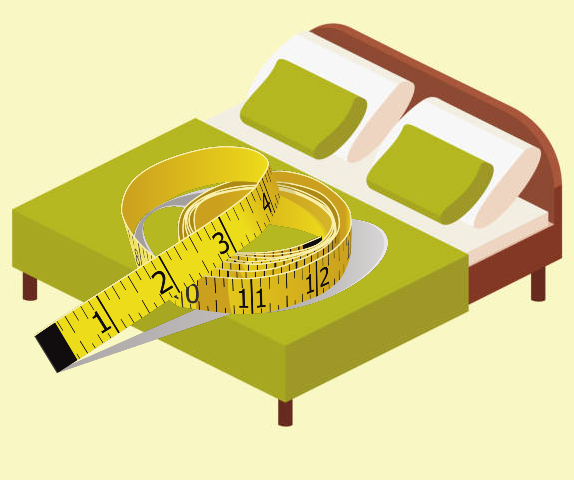
Mattress sizes and dimensions can be confusing, but after a quick tutorial, you’ll be able to choose the correct size and understand difference between twin, full, queen, king, and even unusual sizes.
I’ll explain why a split king set of mattresses works with adjustable bases, and why a California King is slightly longer than other mattresses. First, we’ll start with more commonly purchased sizes like queen and king.
Here’s an illustration of typical bed sizes and dimensions in the U.S. Note that bed sizes vary from country to country, and UK, Australian, and even European sizes are expressed differently. We’re going to start with popular mattresses sizes, work our way down, and even discuss split mattress scenarios and when you would need them.
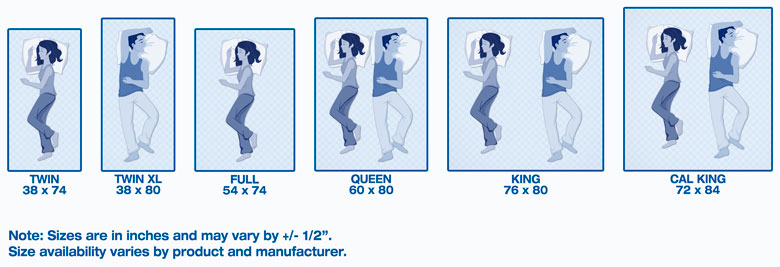
A general piece of advice I give everyone: If you have the room to increase your size, do it! As we move through different phases of life, providing a larger sleep area for yourself is essential to your well being. Here’s a good article which really gets into the weeds of mattress dimensions and sizes by CertiPur® -US
1. QUEEN SIZE BEDS: DIMENSIONS AND APPLICATIONS
Let’s tackle the most common bed sizes first, and fit you to them based on your sleep habits, who you’re sleeping with, kids, pets, available space, etc. Without question the most popular bed size in the States is a queen size mattress, measuring 60” wide by 80” long. Ideal for couples, maybe with one child, a couple with a smaller dog, and of course, for size considerations. You might need a queen size bed if you:
- Have a smaller sized bedroom. The 60” width is 16” trimmer than a king, which is 76” wide, giving you a bit more walking around room.
- Are a couple with no kids, don’t sleep hot, and don’t mind snuggling just a little. A small pet will situate well on a queen.
- Are price conscious… queen size mattresses can be substantially less expensive than a king, largely due to weight. Cost less to ship, esp. if you order online.
- Have a queen bed frame, headboard/footboard that you love. If you downsize to a full size bed or upsize to a king size bed, you’ll have to replace the foundations, the headboard and footboard, and the metal stand or frame underneath.
- Move frequently: Queen size beds are a lot easier to manage than a king, actually about 25% less in weight and bulk.
- Are of typical weight and height. If you are over 250, and your partner is a large person too, you may need a tad more space, and upgrading to King size is often a great idea. You’ll have extra width, and will sleep cooler. If you are over 6’4” tall, 25 years of sales experience has shown us that you’ll do better on a California King, giving you 84” of length vs. 80” on a queen or king.
2. KING SIZE BEDS: DIMENSIONS AND APPLICATIONS
A close second in sales behind queen size beds are king size. It may not sound like a huge difference, but people who jump from queen size to king size will tell you that you’ll never go back. Since many couples eventually upgrade to a king, understanding mattress sizes and dimensions can also help with picking out sheets, comforters, and other accessories.
A king size mattress is 76” wide, a full 16” wider than a queen, and although it’s the same length as a queen, at 80”, the entire mattress just feels immensely larger. You’ll need some more space in your bedroom for walk around and for other pieces of furniture, and you’ll need a metal foundation or frame, headboard/footboard, and foundations.
Note that with a king size mattresses, the foundations are typically split into two sections called “split king” foundations, because there is no way you’d be able to get a 76”x 80” piece through your door (unlike your foldable and bendable mattress). You simply place the foundations side by side on the metal frame or base, and plop the king mattress on top. The seam will not interfere with the feel of the mattress. You might need a king size mattress if you:
- Appreciate the added area advantage. Families with kids, hot sleepers who need space, tossers and turners, large dogs, everyone in this category will love the extra width provided by a king size bed. 76” in width is a full 16” wider than a queen and 22” wider than a full size (also called a “double”).
- Have a large bedroom and you’ve got traditional pieces of furniture, like a dresser, armoire, and other pieces. Mattresses sizes and dimensions can vary depending upon how much space you have.
- Like to use your mattress during the daylight hours as a work surface. That’s right. A lot of king size bed owners have upsized to use their beds as laundry folding tables, play areas for infants and toddlers which you can place safely in the middle with lots of room, and a lounging station for family events like serious gaming.
- Are not too concerned with price. Cost more than a queen, because are buying an additional nine square feet of space. Heavier, and therefore a bit more cost factor in shipping.
When you add children to the mix, bumping up to a king is often a great idea. Especially for infants, providing perimeter space around them reduces safety issues with breathing, etc, too.
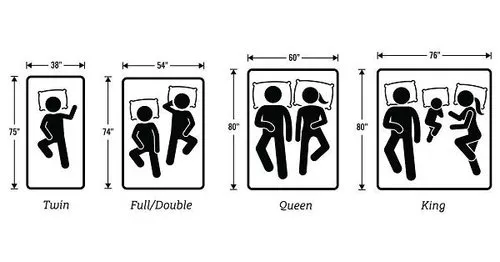
A king size mattress is ideal for a growing family, as well as doubling for the family gathering place and media center. It also provides plenty of room for hot sleepers, tossers and turners, and for sprawling. Even older couples find the extra space of a king mattress enriching, surveys report, resulting in deeper, more restorative and beneficial rest.
3. CAL KING SIZE BEDS: DIMENSIONS & APPLICATIONS
Even though the California King size is perplexing to a lot of people, it seems to have originated on the west coast. The story is that back in 1982, there was a man named David Bergeson from Concord, California. David had uncommonly long legs. This caused issues for him when it came to fitting into a King-sized bed. He had a custom mattress made for himself that added 4” additional inches to the length of a king size bed, and thus created the California King mattress, measuring 72” wide by 84” long.
Note that he also reduced the width from a king size bed having 76” in width to 72” wide, likely because he slept alone. Also, it gave him a tad more “walk around” space by cutting the width by 4”. A perfect solution, and soon mattress makers were building them for plenty of tall folks. They are still available in most brick and mortar stores, as well as a lot of e-commerce sites, including our list of Trusted Dealers.
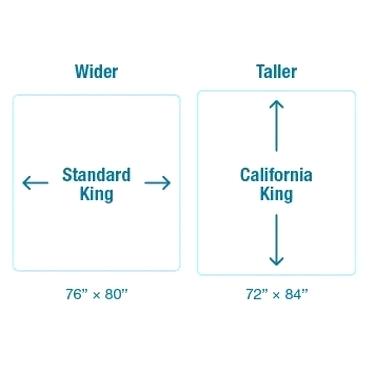
If you are over 6’4”, and like to sprawl, a California king bed may be the perfect solution. However, if you are typical height, have a partner, and have a little more space in your bedroom, take our advice and get a king size bed. Below, we will also get into split Cal king sizes and applications as well.
On the west coast, mattress sizes and dimensions varied more frequently that in large urban centers where space was more limited, and even today, it’s not common to find king size mattresses in apartments or smaller coops and apartment.
4. FULL (DOUBLE) SIZE BEDS: DIMENSIONS & APPLICATIONS
Full size beds used to be the standard go-to size mattress in the U.S., before queen and king variations came along. Pre 1960’s master bedrooms were often equipped with “Ricky and Lucy” beds, meaning two twin (39” x 75”) mattresses separated by the old school nightstand in the middle.
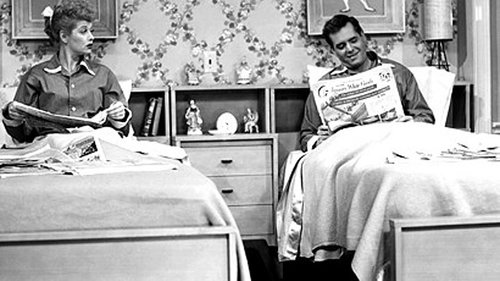
After the sexual revolution in the 60’s, the nightstand was removed and a new lineup of larger mattress sizes swept the marketplace. The full size mattress became the first couples mattress to appear.
Mattress sizes and dimensions have varied according to social norms, also.
Couples snuggled more, and full size and then queen size beds hit the market. Today, however, a full size bed has limited applications, but a lot of them are still sold. For couples, the configuration is tight. Measuring just 54” wide and 75” long, it is 6” less wide than a queen, 22” less wide than a king, and 5” shorter than both a queen and king mattress. These days, they are the perfect starter mattress for singles, especially in urban areas with smaller bedrooms.
Couples often start out with them but typically belly up to the bar at some point to queen size, at least. Note: there is a bed size referred to as “full long” or “full XL”, which is a double or full bed size with an 80” length vs. 75” inch length, primarily designed for taller folks. They are difficult to find, and remember, you’d have to order custom sheets for this obscure size bed. You might need a full size (or double size) bed if you:
- Are limited in space in a bedroom, are designing a guest room for occasional guests (singles or couples).
- Are primarily single, need a little sprawl room, but want to conserve space. Great for singles with small pets.
- Have a tween or teen and want to buy a more spacious bed until they leave home. It’s a nice “upgrade” for kids as they tend to sprawl and use their mattress for media, studying, and lounging, and consumes less room than a queen.
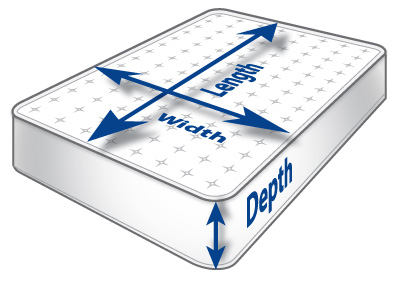
Measure your space and leave room to walk around the bed. If you are thinking about making the jump from a full/double size to a queen size or king size bed check to make sure it fits it in your bedroom with at least 30” of space around the sides and foot.
Mattress sizes and dimensions are conducted with length, width, and depth, as shown.
5. TWIN AND TWIN LONG SIZE BEDS: DIMENSIONS AND APPLICATIONS
Twin size and twin long size beds are made for different purposes. The twin size or single mattress, is 39”x75”, and is designed to accommodate a child or an adult, and are typically used in kid’s bedrooms, small bedrooms, dorms, guest bedrooms, and is wide and long enough for the typically proportioned sleeper. If you are over 6’4” tall, you can opt for a twin long bed size, sometimes called a twin long. Oddly, they are one inch less wide than a regular twin size (38” instead of 39”) but are a full 5” longer, at 80”.
Why the weird disparity between the twin and twin long bed sizes? Easy. A king size mattress can be made by sticking two twin long beds side by side. Their individual sizes being 38” x 80”, when parked side by side, create exactly a king size mattress, at 76” x 80”.

Two twin long beds when combined or parked side by side are referred to as “split king” when you are using an adjustable base setup. Since there are no adjustable bases designed to hold a single king mattress, because of size and access considerations, as well as shipping and install costs
(the base would weigh more than 300 lbs. with motors and mechanisms, etc, and be impossible to easily get upstairs and into a bedroom), a split king adjustable base is always sold with two separate mattresses. Each side offers plenty of space, and can be independently operated with remote controls to provide an infinite number of positions, including head and back tilt, foot tilt, and even “zero gravity” positions. Adjustable bases are extremely beneficial for GERD, for pressure point relief, and make a great family gathering place for Netflix and chill night as well as gaming.
You can check out adjustable bases that I’ve tested and reviewed here.
6. SPLIT QUEEN, SPLIT KING, AND SPLIT CALIFORNIA KING BEDS: DIMENSIONS AND APPLICATIONS
Generally speaking, split queen and split California king sizes are limited to adjustable base applications. Through the years, in our own retail stores and our web sites, we sold a fair number of split queen, but customers who bought them were doing so because of space limitations.
A split queen mattress measures just 30” wide by 80” long, abutted against another piece, thus giving the 60” total width and 80” length. So, if your side of the bed is tilted up and your partners is flat, you don’t have a lot of real estate for sprawling and spreading out.
Split king beds are increasingly popular now with adjustable bases taking flight in the last couple of years. Keep in mind that on a split king bed, each partner will have and additional 8” of width (each split king mattress is 38” wide) vs. the 30” of width on a split queen. Quite a difference. If you are a larger sized couple, rule out a split queen.
For taller folks above 6’4”, consider a split California king, but the tradeoff is that each independent side in a split scenario will 2”less wide than a regular king, but you do pick up that extra 4” of length.
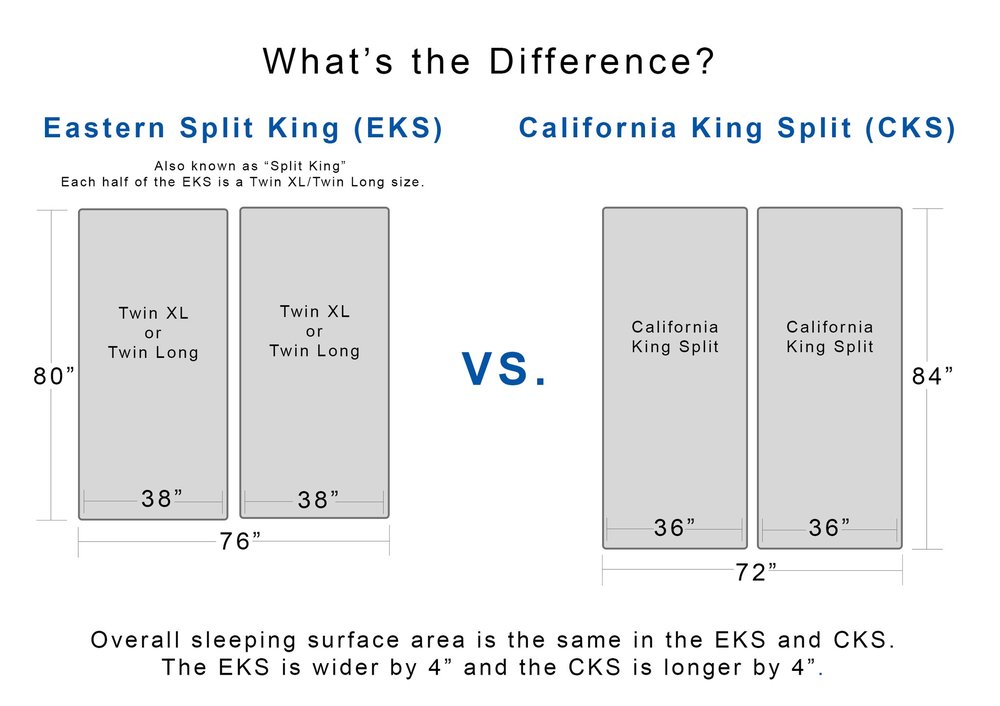
Historically, before they were commonly built in one piece, a traditional King bed was manufactured in two separate pieces to aid in moving, along with two separate box springs or foundations. The older spring-coil mattresses were flexible around corners, but the solid base needed to be broken up to be moved easily into a home and room.
These days, unless you are buying split king beds for an adjustable base setup, most king mattress, especially those purchased online that are rolled and compressed, can easily be brought directly to a bedroom, even with winding staircases and narrow access.
Even if you are buying a one piece king mattress, you’ll still be using a split foundation setup, that is two separate foundations (old school term: box springs) as your base, which will set on top of a traditional metal frame or platform bed, or slatted deck between a headboard and footboard.
Also, two split king mattresses (two twin longs, again) used with adjustable bases placed side-by-side can be synced together for those preferring that the entire bed be moved up and down simultaneously, or can be operated independently for each partners needs.
WHILE WE’RE AT IT, LET’S TALK SHEET AND COMFORTER SIZES FOR DIFFERENT MATTRESSES
So, you’ve checked out our Trusted Dealer page and bought a mattress. You’ve got everything you need except for sheets, pillow cases, and a comforter. There’s some stuff to think about- like sheet depth, split mattress sheets (typically you get two fitted sheets, but only one flat sheet, by the way), and what size comforter will look appropriate on your mattress? Let’s break it down.
ALL ABOUT SHEETS – SIZES, MATERIAL, THREAD COUNT, AND MUCH MORE
Let’s talk about thread count. People make a big deal out of 1,000 thread count sheets being the best, the most luxurious. We sold sheets for 25 years in stores and on web sites, and we can tell you, don’t waste your money. High thread count sheets are hot, heavy, and total overkill.
Thread count for sheets refers to the number of threads woven into 1 square inch of fabric. Why does it matter? The smoothest and softest sheets will have higher thread count, but it also a function of material. Some 200 thread count sheets in combed cotton are simply more scrumptious that satin 600 thread count.
Thread count also determines whether a sheet is muslin or percale. Sheets with a thread count of 140-180 are muslin. Everything higher is percale. The most common percale sheets have thread counts of 180-200. Higher-quality sheets have a 250-300 thread count and feel silky to the touch.
Sheets with a high thread count (300-400) are considered luxury quality. The sweet spot? We suggest 300 thread count for extreme breathability, a nice weight, not too light, but enough to envelope your body.
When buying cotton-polyester blend sheets, choose a thread count of 220 or more. Expect to pay more for higher thread counts because it takes more finely spun threads to make them.
STANDARD SHEET MATERIALS
For comfort and durability, cotton sheets are the best. Want a natural, breathable fabric? Choose 100 percent cotton. If you are allergic to dyes and chemicals, look for sheets made from organically grown, natural, and uncolored cotton fibers. Keep in mind though, that some organic sheets can be coarse and a little rougher than processed fibers.
Beyond the basic materials, your sheet experience can be totally customizable. You’ll find a variety of performance sheets, designed to deliver a particular experience. For example, cooling sheets are designed to be more breathable and to wick moisture. Do a little research on the available options and look for the best sheets to give you what you need for a good night’s sleep.
OTHER SHEET MATERIALS
Want to find the best bed sheets for your sleeping requirements? Read up on the different sheet materials and pick a material that meets your needs.
- Flannel, muslin, oxford, percale, and sateen weaves are most commonly used for cotton bed sheets. Percale, which is tightly woven, is still a basic and popular weave for sheets, as is sateen.
- Muslin sheets come at a lower price point than percale because prices are typically based on thread counts. Look for wrinkle-resistant cotton sheets as an alternative to stiff cotton-polyester blends. Machine-washable, combed-cotton percale with a thread count of 200-250 will provide long wear.
- 50 percent cotton/50 percent polyester sheets resist wrinkling but can be stiff. The 60 percent cotton/40 percent polyester blend is another option. Look for a high thread count (above 220) to ensure quality in cotton-polyester blends.
- Silk satin sheets are ideal for cold climates because the material traps warmth. These sheets feel smooth and luxurious, but they are expensive and must be dry-cleaned. Avoid satin-style sheets made of polyester; they feel scratchy against the skin.
- Cotton jersey knit is made from the same breathable fabric as cotton T-shirts and is comfortable year-round. Dark colors and patterns tend to fade, however.
- Linen, which is ideal for hot climates, is considered the finest sheet fabric. Fine linen sheets last for decades, making them a worthwhile investment.
Not sure which bed sheet fabric is best for you? Buy a pair of pillowcases and see how you like them before committing to a complete set of sheets.
SHEET SIZES
Getting ready to buy sheets? Start by carefully measuring the mattress. Mattress sizes can vary, especially in thickness or depth, and you want to make sure you’re getting the right size for your bed. Write down your mattress dimensions, measuring from head to foot, side to side, and top to bottom (mattress thickness). That way you’ll know exactly what you need.
These are the standard sheet sizes, listed in inches, for typical mattress options.
Twin Bed: The twin or single mattress is usually meant for one person.
- Twin flat sheet: 66×96 inches
- Twin fitted sheet: 39×75 inches
- Pillowcase: 20×26 inches (usually only one with a boxed set)
Twin Extra-Long Bed: Typically used in a split king bed for adjustable bases these days. Sometimes found in college dorm rooms, this mattress is longer than the standard twin.
- Twin XL flat: 66×96 inches if purchased as a stand alone TXL set, not marked as “split king”. For split king set, the flat sheet will measure 102×108, in a boxed set with two twin long fitted sheets
- Twin XL fitted: 39×80 inches
- Pillowcase: 20×26 inches (one with TXL set, two with Split King set)
Full-Size Bed: Also known as a double, this mattress can sleep two.
- Full flat: 81×96 (up to 100 inches)- one piece in set
- Full fitted: 54×75 inches- one piece in set
- Pillowcase: 20×26 inches- two pieces per set
Queen-Size Bed: The queen mattress sleeps two. It is both longer and wider than a full-size mattress.
- Queen flat: 90”x102” (up to 106 inches)
- Queen fitted: 60”x80”
- Pillowcase: 20”x30”
Split Queen Configuration: Two 30”x80” mattresses for use on an adjustable base, when butted against one another create the standard 60”x80” queen configuration.
- Split Queen flat: one piece, 90”x102” (up to 106 inches)
- Split Queen fitted: two pieces, 30”x80” each
- Pillowcase: 2 each, 20”x30” inches
King-Size Bed: Also known as the Eastern king…
- King flat: 108”x102” (up to 106 inches)
- King fitted: 78”x80” inches
- Pillowcase: 2 each, 20”x36” (up to 40 inches)
Split King Size Bed: typically for adjustable base use. Note: you can choose two approaches for this setup. If each partner prefers their own fitted sheet, buy two Twin Long sets. If you prefer one king size fitted sheet that will cover the entire configuration, buy the split king set as described here:
- Split King flat: one piece, 108”x102”
- Split King fitted: two pieces, 38”x80” each
- Pillowcases: 2 each, 20”x36”
California King Bed: This mattress is longer and narrower than the Eastern king. Recommended for folks over 6’4” tall
- California king flat: 102×110 inches
- California king fitted: 72×84 inches
- Pillowcase: 2 each, 20×36 (up to 40 inches)
Split California King Bed: Designed for adjustable base application. Recommended for folks over 6’4” tall
- Split California king flat: 102×110 inches
- Split California king fitted: two pieces, 36”x84” each
- Pillowcase: 2 each, 20×36 (up to 40 inches)
MATTRESS DEPTHS
Many newer beds feature pillow-top or extra-deep mattresses, which often run 14-16 inches deep—and some even thicker. Use these mattress depths as a guide when selecting sheets. Bear in mind that you might need to get the next size up (e.g. a king flat sheet for a queen-size bed) to accommodate a deeper mattress, though most king sheets sets are now available in a variety of depths.
- Standard: 7-9 inches
- Deep: Up to 15 inches
- Extra-Deep: 16-22 inches
STOCKING UP ON BED SHEETS: WHAT YOU SHOULD KEEP
Traditionally, sheets are a lot less expensive during January white sales and are an ideal time to score new sheets. Linen outlets are year-round destinations for bargain hunters and you might be surprised by what you can find, including some of the best sheets at great prices.
For the most savings on quality sheets, look for sales of marked-down individual sheets instead of sets. Mix and match fitted and flat sheets with pillowcases and shams. For mixing, choose white or a solid pastel for one of the sheets or for the pillowcases. Another smart strategy: Consider buying identical sets of sheets so that you can trade off sheets if something spills or a sheet gets damaged.
Keep some stock with these items to dress every bed in comfort and style:
Master Bedroom:
- Two or three sheet sets in the correct size. Each sheet set should include top (flat) and bottom (fitted) sheets plus two pillowcases. You may need additional pillowcases if you use more than two pillows. Change and launder sheets and pillowcases once a week.
- Two mattress pads: one in the linen closet, one on the bed. Wash every two to four weeks.
- Two pillowcase protectors per pillow
- One duvet and duvet cover or comforter
- One coverlet, quilt, or spread
- One summer and one winter blanket
Guest Bedroom:
- Two sets of sheets per bed. Wash linens and remake the bed after each visit so the room will always be ready. Note that a twin sheet set includes only one pillowcase.
- One mattress pad for each bed
- Two pillows per twin bed; four pillows per full-size bed
- Two pillowcase protectors
- Two pillow cases per pillow
- One duvet and duvet cover or comforter per bed
- One summer and one winter blanket
BED QUILTS AND COMFORTERS
Matching a Comforter to Your Mattress
The standard categories offer a starting point for selecting a comforter that matches your bed mattress. If you have a twin-sized mattress, for example, you’ll want to purchase a comforter labeled as such. Likewise, if you have a king-sized mattress, purchase a king-sized comforter. But within each category, comforters come in a range of lengths and widths, and here is where you need to pay attention to the thickness of your mattress. If your own mattress is on the thick side, you’ll need to look for a comforter at the top range of the dimension range—or in some cases, you might even jump up to the next category.
Choosing the right comforter size tends to be trickiest with a full-sized or queen-sized bed since manufacturers often confuse their sizing standards by claiming their comforters are sized for both sizes. In practice, if you purchase a queen comforter labeled for a full/queen bed for your full-sized bed, you may find its edges fall closer to the floor than you wish. Take field measurements of the desired drop length for both sides and foot of your bed with you to the store or have them available for online shopping.
On the other hand, if you have a queen-sized bed and you purchase a comforter labeled as full/queen, you may find that it is not quite wide enough to cover your bed adequately. In this case, you may want to shop specifically for the queen comforter size, or at least make sure the full/queen comforter you’re considering is on the wider side (86″ to 88″, rather than 84″).
Some of this may depend on the thickness of your mattress, as well. If you have a particularly thin bed—a futon or something like it—you probably can get away with a narrower comforter, since you’ll need less of it to cover the sides of your bed. On the other hand, newer pillow-top mattresses can be as deep as 14″ to 16″, and here you’ll need a considerably wider comforter to cover the sides of the mattress completely.
One good way to approach this is with simple measurements: take the top dimension of your mattress and add the thickness of the mattress to the length and to each side of the comforter dimensions. This should ensure that the comforter drapes down fully over the end and sides of the mattress. For example, a twin bed mattress that is 39 inches wide and 75 inches long and 12 inches thick, will need a comforter that is 63 inches wide (12 inches on each side) and 87 inches long in order to fully cover the sides and the bottom end of the mattress. A few extra inches might be even better, especially if the comforter is on the puffy side.
Mattress thicknesses vary widely by manufacturer, although thicker mattresses are far more common than they were a few years ago. Standard and older mattresses average between 9″ and 12″ deep, which means they’ll work with most standard comforter sizes. But newer pillow-top mattresses may be as thick as 20 inches, which will call for a considerably larger comforter. Gauging the right size depends on personal choices also, not just with mattress sizes and dimensions.
OVERSIZED COMFORTERS
Due to the recent popularity of thick, pillow-top mattresses, some manufacturers are offering “oversized queen” and “oversized king” comforter sizes in addition to their standard sizes. These comforters have more width for their length: in the case of queen comforters, they’re usually around 98 inches wide, and in the case of king comforters, they’re usually around 115 inches wide. If you want a wide comforter but don’t want to jump up to the next standard size, these may represent a good compromise.
It is generally fine for the comforter to be slightly oversized so it hangs below the bottom of the mattress. The space between the bottom of the mattress and the floor is often covered with a bed skirt or ruffle, and it is visually more pleasing for the comforter to overlap the skirt than for it to fall short.